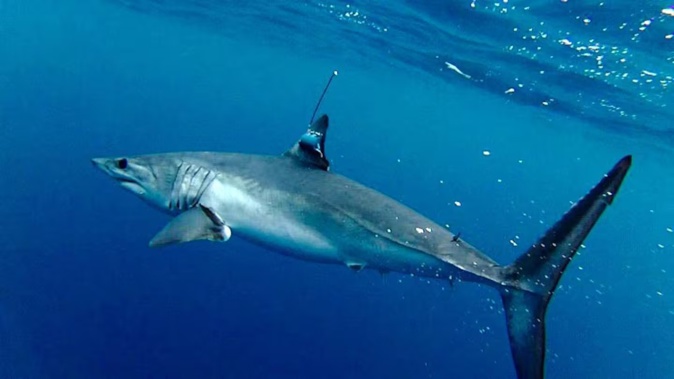
In the so-bad-it’s-good TV movie Sharknado, heroes armed with bombs and chain saws battle sharks tossed inland by a hurricane.
In reality, biologists have found a way for sharks to help anticipate the next big storm.
Researchers are enlisting sharks as mobile marine monitors, attaching sensors to their dorsal fins.
The hope is that as the sharks swim through the ocean, they will collect temperature readings and other information that can be used to predict the power and trajectory of Atlantic hurricanes.
The work comes as the Trump Administration slashes staff and funding at the National Oceanic and Atmospheric Administration (Noaa), potentially hindering its ability to forecast hurricanes.
The sharks aren’t meant to replace human forecasters in any way, but they could add to the stream of data that forecasters analyse.
“The ocean is so huge, so enormous, that it’s just inaccessible to anything, for the most part,” said Aaron Carlisle, a University of Delaware marine ecologist leading the effort.
“But by instrumenting the animals that live out thereyou can basically turn them into these ocean sensors that are constantly collecting data.”
Hurricanes form as the atmosphere sucks up heat from water, causing air to rise and form clouds that uncork torrential rain.
Measuring the distribution of heat in the ocean is key to predicting where hurricanes will go and how strong they will be.
“The ocean is the heat engine for hurricanes. If they’re going to intensify, usually they’re going to go over hot water,” said Travis Miles, a physical oceanographer at Rutgers University. “If they go over cold water, they’re going to weaken.”
Taking the temperature of the Atlantic Ocean at various depths is no easy task.
Weather satellites cannot see past the sea surface, which in the Atlantic often conceals pools of cool water.
The robotic floats and gliders that meteorologists deploy to measure below-surface temperatures move slowly and are expensive to operate, leaving many data gaps in the open ocean.
“The scale of the ocean is just so massive and vast that we really have a lot of empty space where we need more observations,” said Miles, who is not involved in the shark research.
The lack of data is especially acute in hurricane-prone waters in the Caribbean, Gulf of Mexico and off the East Coast, he added.
Animal helpers
Several different types of animals have served as ocean sentinels.
For years, researchers have tagged southern elephant seals in the Antarctic and narwhals in the Arctic with monitors that track temperature and other conditions in otherwise difficult-to-reach polar regions.
Russia has even tried recruiting dolphins and beluga whales as intelligence-gathering assets.
Now, to gather intelligence in the Atlantic, Carlisle and his colleagues are turning to sharks.
“Sharks are faster than [robotic] gliders. They can stay out for longer periods of time,” said Caroline Wiernicki, a shark ecologist and PhD student working with Carlisle.
“So the hope is that we can have these sharks go out and work in concert” with existing monitors.
In May, the team threw baited hooks and blocks of frozen chum off a boat 60-80km offshore, causing an oily sheen to stretch for kilometres. “It lays out a scent trail,” Carlisle said. “Any shark that comes across it is going to think, ‘Ooo, what’s that?’ And then they start following it up.”
The team detained two shortfin makos and attached sensors to measure the temperature, salinity and depth of the seawater. The researchers chose the makos because they return to the surface often, enabling the tags to relay the information to satellites.
Makos are endangered as a result of overfishing, according to the International Union for Conservation of Nature.
Overall, one in three species of sharks and their cousins are threatened with extinction.
Movies like Sharknado and Jaws - which debuted 50 years ago this year - have characterised sharks as ruthless killing machines and may have worked against efforts to protect them.
But the researchers say they are big fans of sharks and don’t expect the sensors to have much harmful impact on them.
“We do everything we can to minimise” the impact of puncturing the animals’ fins,” Carlisle said. “We all love the animals, so we don’t want to hurt them.”
So far, one of the two sharks has relayed temperature data to the researchers.
The other has swum in water too shallow for the sensor to turn on.
“Each time we put one out, we learn something new, and it’s a debugging exercise,” Wiernicki said.
The work has been “a great proof of concept”, Carlisle added.
The plan is to tag dozens of sharks a year, Wiernicki said, with the aim of feeding the data into existing hurricane computer models so they produce more accurate forecasts.
In addition to the makos, the crew also caught and installed a satellite tag on a great white to track its location, but not to read temperature. That species is also a candidate for becoming a weather monitor.
The team hopes to test tagging other species, including hammerheads and whale sharks.
“The more data we have, the better things will be,” said Jill Trepanier, a Louisiana State University professor specialising in hurricane climatology who is not involved in the project.
“So, if it’s a shark collecting it or a buoy or glider, I say, go for it.”
Take your Radio, Podcasts and Music with you









